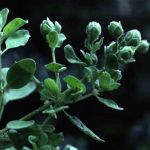| Common Name: |
Knotted Marjoram |
| Other Names: |
Sweet Marjoram |
| Botanical Name: |
Origanum majorana syn. (Majorana hortensis) |
| Genus: |
Origanum |
| Family: |
Lamiaceae |
| Cultivation: |
Well-drained to dry, neutral to alkaline soil in sun. Origanum dictamnus needs sharp drainage and protection from wet winters. Orgianum majorana, O. x majoricum, and O. onites may be slightly hardier in a sheltered, sharply drained situation. |
| Propagation: |
By seed sown in autumn or at 10-13°C (50-55°F) in spring (species only); by basal cuttings in late spring; by division in spring. |
| Harvest: |
Plants are collected as flowering begins, and leaves during the growing season, and sued fresh, distilled for oil, or dried for infusions. |
| Native Location: |
S Europe, N Africa, Turkey |
| Height: |
60cm (24in) |
| Width: |
45cm (18in) |
| Hardiness: |
Z9-10 |
| Parts Used: |
Whole plant, leaves, flowering heads, seeds, oil |
| Properties: |
A warming, relaxing, restorative herb that relieves spasms, stimulates the uterus and circulation, and improves digestion, and has expectorant effects. It has a sweet, floral, thyme-like aroma. |
| Medicinal Uses: |
Internally for bronchial complaints, tension headaches, insomnia, anxiety, minor digestive upsets, and painful menstruation. Contraindicated during pregnancy. Externally for bronchial congestion, muscular pain, arthritis, sprains, and stiff joints; also infused in warm olive oil for ear infections. |
| Culinary Uses: |
Origanum majorana has a more delicate flavor than O. vulgare and is best used fresh toward the end of cooking. Leaves and flowering sprigs are popular in Italian and Greek cooking, with meat dishes, soups, stuffings, tomato sauces, and pasta, and to flavor oil and vinegar. |
| Economic Uses: |
Seeds are added to condiments and meat products. Oil is used in commercial food flavoring, liqueurs, perfumery, soaps, and hair products. |
| Bibliography: |
Encyclopedia of Herbs by Deni Brown. Copyright © 1995, 2001 Dorling Kindersley Limited. pp 295-296
|

